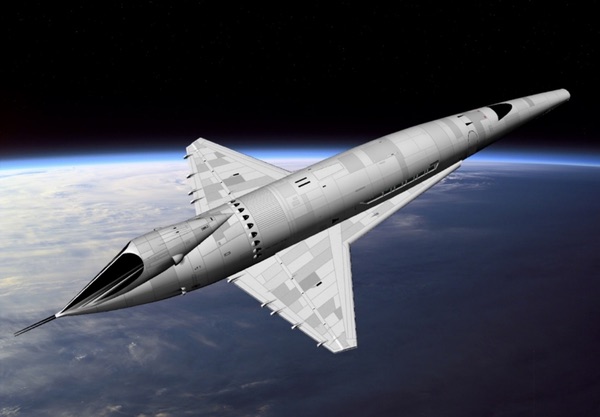Solving the commercial passenger spaceflight puzzle (part 1)by Mike Snead, P.E.
|
| To truly open space to civilization, we must now carefully select the ethical path to achieve acceptable passenger spaceflight safety. |
Dr. Heywood Floyd’s trip to space aboard the Orion III spaceliner—the orbiter part of a two-stage-to-orbit, fully-reusable commercial passenger spaceflight system—caught everyone by surprise. Compared to the three-person Apollo capsule atop the massive Saturn V, an ability to travel to space in comfort as a typical flight passenger, while wearing a business suit, set the standard for what the future of commercial passenger spaceflight “should be.” It is a goal that, 50 years later, we are still struggling to achieve, puzzled why this has not yet happened.
The focus of this three-part article is on commercial passenger spaceflight safety—what this ethically means and how to achieve it now. Without acceptable safety, a real version of Floyd’s travels to and within space will simply not happen. Despite what some would have us believe, outer space will not be permanently opened to commercial development and settlement without first establishing acceptably safe commercial passenger spaceflight.
The key question, of course, is what constitutes “acceptably safe” passenger spaceflight. Developing acceptably safe human systems is fundamental to the ethical practice of engineering. For some—the extraordinary risk takers—a real threat of death is part of the allure of the activity, such as climbing Mount Everest. In the civilized world—which many like myself hope to extend into space—risk is intentionally reduced through the implementation of the best-available engineering principles and practices. For air travel, these are embodied in airworthiness regulations. To truly open space to civilization, we must now carefully select the ethical path to achieve acceptable passenger spaceflight safety. Otherwise, more time and—especially—hard-to-replace funding will be wasted.
I am addressing this question in three parts. In this Part 1, I critique a proposal to establish a “regulated self-policing” approach to commercial human spaceflight safety certification. Finding the proposed approach, largely based on NASA’s “human-rated” safety process, to be unethical for commercial passenger use, I explain in Part 2 why the airworthiness approach yielding acceptably safe passenger air travel should be extended to all commercial passenger spaceflight. In the concluding Part 3, I describe how to proceed with creating an initial commercial passenger spaceflight industry, including a technical approach for developing a “DC-3” passenger spaceliner, as the initial step in building a broader American astrologistics infrastructure.
Making spaceflight safety a national priority
On the recent 50th anniversary of the Apollo 11 landing, one evening national news broadcast featured a 58-year-old woman. She was excited about the possibility that the long-awaited commercial suborbital spaceflight participant rides—legally not commercial spaceflight passenger rides—were “about” to commence.
Mesmerized by the billionaire boys of space, the “objective” news media has turned a blind eye to the safety of their version of human spaceflight. It is reminiscent of the lead-up to the fatal 1986 flight of the Space Shuttle Challenger, which was to fly the first civilian, a teacher, into space. The inherent risk the teacher was taking was part of the mission hype rather than a serious discussion of whether the teacher was intellectually capable of understanding and assessing the risk of losing her life—of making a true informed consent. Flying on the Space Shuttle was, we were then told, almost as safe as flying on an airliner. On that early shuttle mission, the probability of loss of crew is now estimated to have been 1 in 10; not the 1-in-1000 the public was led to believe. Yes, 1 in 10! Do you think that she—a schoolteacher and mother—would have signed on had she known this? Would the public have accepted this? Of course not!
NASA had turned the process of selecting the teacher into a giant publicity stunt. The selected teacher became a national media star. After disregarding known safety hazards with the seals in the giant solid rocket boosters, problems exacerbated on the exceptionally cold launch day in Florida, as the teacher boarded the shuttle, looking every bit an astronaut in her flight suit, her safety was not NASA’s foremost priority. The shocked world watched her and the rest of the crew die live on NASA TV. NASA’s public image of flight safety integrity evaporated.
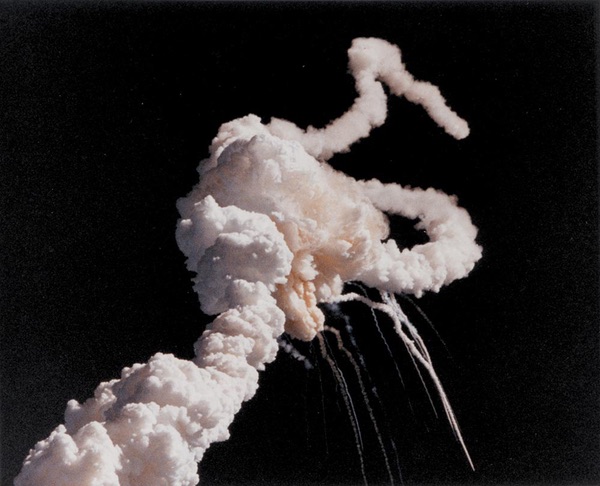 Loss of the crew of the Space Shuttle Challenger in 1986. (Credit: NASA) |
We are repeatedly told that human spaceflight is inherently more dangerous. In its “human-rated” requirements document, NASA says “that a certain level of risk needs to be accepted to conduct human spaceflight.” This thinking will only open space to the foolishly bold and brave—such as those who free-climb mountains or wingsuit glide down mountainsides—or those who are wealthy but particularly naïve. I believe this mindset will lead to more Challenger-like failures in the future, such as the loss of the crew of the Columbia in 2003 due to poor safety decisions.
America must change course regarding human spaceflight safety. Achieving acceptable commercial passenger spaceflight safety must be made a national space policy priority if we are to open space to development and settlement. To understand why changes are needed, the two current federal approaches to human spaceflight safety must be explained.
The current federal law regarding suborbital human spaceflight is simply bizarre and immoral
Returning to the woman wishing to experience suborbital spaceflight, per federal law, assuring her safety is unimportant to the government. Should she undertake a commercial suborbital spaceflight, she will be required to sign a comprehensive waiver absolving everyone, especially including the government, of any liability should harm or death occur. Federal law presumes the average person has the wherewithal to ascertain the level of risk involved and the integrity of the spaceflight operations. This is nonsense!
| Achieving acceptable commercial passenger spaceflight safety must be made a national space policy priority if we are to open space to development and settlement. |
To further confuse the topic of safety, federal law forbids the use of the standard commercial term “passenger,” instead substituting “spaceflight participant.” Only lawyers understand the legal significance of this change with respect to the owner/operator’s common law “duty to care” obligation regarding the safety of their passengers. The change to spaceflight participant generally abrogates this obligation.
One the same day as the 50th anniversary national news broadcast, the local news reported that several rides at the state fair were shut down due to not being assuredly safe. One was permanently shut down because of visible corrosion. Several years ago, a person died when a ride at that state fair failed. Now, per state law and common sense, the safety of the ride participants is paramount to the extent that the state government took on the final responsibility to inspect the rides to ascertain their safety and close rides where the safety could not be assured by operational inspection.
In our litigious world, public safety is increasing in importance—except in the area of human spaceflight. Per federal law, there is no current requirement for the federal government to inspect and ascertain the safety of a commercial suborbital human spaceflight system except to protect the safety of the public on the ground or flying in the shared airspace. Isn’t this bizarre! A state government will inspect a fair ride called “Travel to Space” to protect the public’s safety, but the federal government will not inspect and certify the acceptable safety of a commercial suborbital human spaceflight system to protect an American spaceflight participant engaged in this legal commerce. The current 2004 federal law addressing suborbital human spaceflight is immoral and must be changed.
NASA is currently responsible for orbital American spaceflight safety
For human orbital spaceflight originating in the United States, there is no current operational capability. NASA ended Space Shuttle operations in 2011 without, for the first time in US history, replacing an important national infrastructure with a better, safer capability. With NASA able to purchase rides to the International Space Station (ISS) from Russia, NASA did not have a true operational deficiency driving the development of an immediate replacement system. Instead, NASA focused on developing the Apollo-like Orion capsule spacecraft to be launched on the expendable Space Launch System and paying for the development of two smaller, less capable space capsules to transport astronauts to the ISS. This is the commercial crew program.
My understanding is that, per federal law, the NASA administrator is the authorizing authority for approving human spaceflight on NASA systems. To implement this authority, NASA developed its “human-rated” approach to human spaceflight safety. The “human-rated” approach has evolved over the years. NASA NPR 8705.2C, Human-Rating Requirements for Space Systems, is the current statement of NASA’s certification process and requirements. The following two quotations outline the purpose and responsibilities:
The purpose of this NASA Procedural Requirements (NPR) document is to define and implement the additional processes, procedures, and requirements necessary to produce human-rated space systems that protect the safety of the crew and passengers on NASA space missions.
The Program Manager is expected to evaluate the intent of these technical requirements and use the talents of the development and operation team to design the safest practical system that accomplishes the mission within constraints. By doing so, the program is expected to arrive at an optimal solution that represents the best overall value considering cost, schedule, performance, and safety. [emphasis added]
| The current 2004 federal law addressing suborbital human spaceflight is immoral and must be changed. |
Note that safety is the “and” requirement, establishing its apparent importance in the hierarchy of program manager responsibilities; perhaps reflecting NASA’s acceptance of “a certain level of risk” and designing the “safest practical system that accomplishes the mission within constraints.” I think it is fair to say that these are inferior to the public’s expectations of the importance of safety for commercial systems providing public transportation services.
Space Shuttle probability of loss of crew
The Space Shuttle system was developed and operated under previous versions of NASA’s human-rated requirements. After the conclusion of shuttle operations, NASA was directed by its independent Aerospace Safety Advisory Panel to conduct a retrospective assessment of the probability of loss of crew (LOC) throughout the 30-year operational life of the system. The figure below shows the results For example, an LOC probability of 1 in 10 missions plots as a value of 0.1 or 10 percent. Notations indicate what changes were made to the shuttle system that affected the estimated LOC. The Challenger mission was #25 while the Columbia mission was #113.
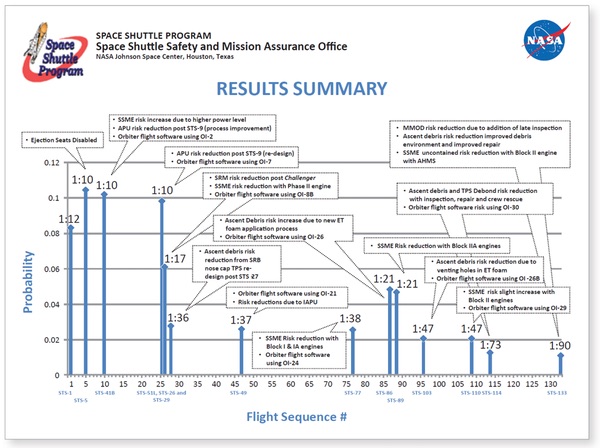 Summary of the retrospective analytical assessment of the probability of loss of crew over the 30-year operational life of the Space Shuttle system. [larger version] (Credit: NASA) |
The panel’s 2011 report noted, “In the Shuttle’s case, the first flight risk as now retrospectively calculated was in actuality 1 in 12 for LOC, yet at least one analysis that existed at the time of the initial launch estimated the risk to be 1 in 1,000 or better.” If the earlier analysis had predicted a 1 in 12 LOC probability on the first flight and this was known to the public, would the shuttle ever have flown? (Note that the retrospective LOC probability through Challenger mission #25 was 1 in 10.)
NASA made improvements to the Space Shuttle system throughout its operational life. Many of these, especially with the main engines, were noteworthy technological advances. However, even at the end of its 30-year history, the LOC probability had only improved to 1 in 90. By then, there had been two mission losses with the second mission—Columbia in 2003—being lost due to known but unresolved hazards related to the expendable External Tank’s external insulation.
It is reasonable to suspect that NASA had an idea of the actual low shuttle LOC probability throughout most of the 30 years. This helps us to understand what NASA really means when saying, in NPR 8705.2C, “that a certain level of risk needs to be accepted to conduct human spaceflight” and designing the “safest practical system that accomplishes the mission within constraints.”
It took the actions of NASA’s quasi-independent safety panel—after decades of operations—to publicly identify this substantial discrepancy between the implied safety of NASA’s “human-rated” safety regime and what was going on. This indicates that safety is apparently not the priority within NASA as the public has been led to believe as it is hard to believe that the true state of the Shuttle’s safety was unknown within NASA. Essentially, “human-rated” safety was whatever the NASA astronauts were willing to sign on to do.
It is best to think of NASA astronauts as being comparable to test pilots from the early days of aeronautics. Test pilots were the final judge of the airworthiness of a new aircraft based on the technical information gained from close observation of the aircraft’s development and the “feedback” from close program associates. Like test pilots, astronauts are employees voluntarily engaged in providing a service to their employer. Many employees volunteer for dangerous jobs—first responders, for example. Even then, however, normal life experience in the United States today does not provide an appreciation of what a 1-in-10 chance of death really means. Americans haven’t experienced this level of risk since World War II-era combat such as bombing missions over Germany.
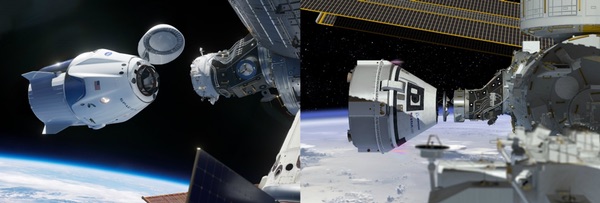 SpaceX’s Crew Dragon capsule (left) and Boeing’s CST-100 capsule (right) being developed in NASA’s Commercial Crew System program. (Credit: NASA) |
The SpaceX Crew Dragon commercial crew system
As previously mentioned, NASA’s commercial crew program is developing several additional means of transporting NASA astronauts to the ISS. Two of these, as seen above, involve the use of capsules that will be launched on rockets. Both are nearing their first human flights. Somewhat of a surprise, NASA astronauts will be the first to fly rather than company astronauts—a reverse of the normal flight test approach for government-acquired aircraft.
A SpaceX Crew Dragon test capsule, Demo 1, was the first to fly—uncrewed—to the ISS. On its return to the Earth, it was recovered and processed for further testing. The company’s plan was to fly it a second time, also uncrewed, to activate and test the ascent escape system during an actual ascent.
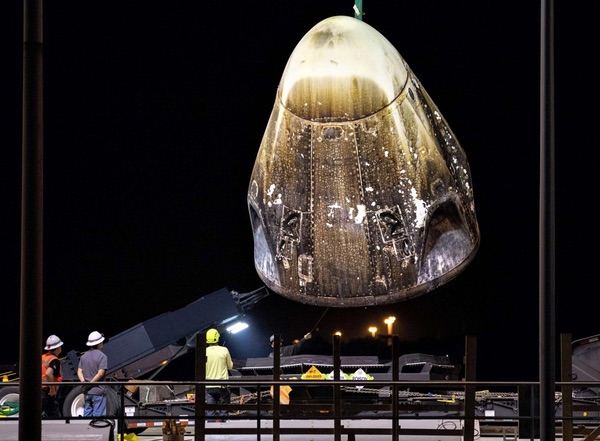 Return of the Crew Dragon Demo 1 capsule flown unmanned to the International Space Station. This was the capsule subsequently destroyed during a static ground abort system test firing. (Credit: NASA) |
The Crew Dragon capsule integrates the rockets needed for ascent escape into the base of the capsule. My understanding is that this design approach was selected by SpaceX to enable the capsule to be used for other missions where a powered landing, rather than parachutes, would be used. The ascent escape rocket engines are called SuperDraco.
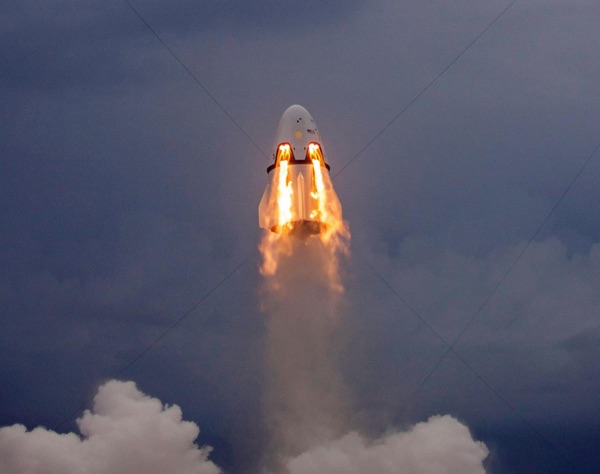 Earlier free flight test of the Dragon Crew abort system. This was a test capsule, not the flown capsule that failed. (Credit: NASA) |
Prior to launching this vehicle on its second flight test, the capsule’s SuperDraco engines were to be test fired in a ground static test. Less than a second before ignition of the SuperDracos during this ground test, a fire erupted destroying the capsule. As of this writing, investigation into the cause of the apparent failure is ongoing, although SpaceX says the most likely cause appears to involve valves that allowed fuel to leak through prior to pressurization of the system just before ignition. NASA has not yet released images of the capsule after that test, although some images and video are available online.
| Normal life experience in the United States today does not provide an appreciation of what a 1-in-10 chance of death really means. Americans haven’t experienced this level of risk since World War II-era combat such as bombing missions over Germany. |
SpaceX’s test program to that point appears to have been competently undertaken. After the failure, NASA commented that, “Over the course of development, SpaceX has tested the SuperDraco thrusters hundreds of times.” In previous tests, the entire SuperDraco abort system had been test flown, but in a test capsule. My impression is that the ground static test was the first for a flight capsule during which a previously undiscovered design, manufacturing, or assembly error resulted in the fire. For this discussion of commercial passenger spaceflight safety, the reason why the Crew Dragon needed an ascent abort system is important to understand.
How “human-rated” safety drove the Crew Dragon design
At the end of its operational life, the Space Shuttle’s estimated LOC probability was still only 1 in 90. For the follow-on human spaceflight systems, my understanding is that NASA initially aimed to achieve a 1-in-1000 LOC probability—comparable to what the public was led to believe at the start of shuttle operations. This LOC estimate was not just for ascent but covered everything from the time the astronauts arrived at the launch pad to their return to land. Some of the hazards were human created, such as incorrect manufacturing or assembly, while some were natural, such as solar flares and space debris impact.
Early full-mission LOC probability estimates apparently found that achieving 1 in 1000 would be difficult, especially with unknown natural hazards acting on skimpy capsules. Consequently, per my understanding, NASA set the LOC target at three times the last shuttle value, which is 1 in 270. For the Commercial Crew Program, SpaceX and Boeing elected to propose developing—and NASA accepted—transport systems using conventional rockets and space capsules. It was up to these companies to provide an integrated system with their LOC probability no worse than 1 in 270. (Note that preparing probability estimates are actually quite complex. Saying the probability should be no worse than 1 in 270 is a simplification.)
Had the proposed systems been “aircraft-like” by being fully-reusable, each production system could have been flight tested to establish its proper functioning and actual operational safety prior to delivery to NASA for use in transporting astronauts to the ISS. Under such conditions there would be no statistical justification for needing an emergency ascent escape system just as commercial airliners don’t have such systems. (As I will discuss in Part 3, NASA had the opportunity to develop such a system.) Historically, space launch rockets have a launch failure rate around two to three percent. For example, the October 2018 launch of the crewed Soyuz experienced an ascent rocket failure, initiating an emergency separation and recovery of the capsule. By accepting proposals for systems that were not fully reusable, the need for an ascent escape system was imposed by NASA’s “human-rated” requirements. NASA’s decision to accept such proposals was, apparently, an implementation of their core willingness to accept “a certain level of risk” substantially worse than that of an airworthiness certified system.
Using the historical rocket launch failure rate, the probability of a rocket failure would be around 1 in 50. Without an ascent escape system, the crew would, of course, be lost. Hence, the purpose of the ascent escape system is to boost the LOC probability to a minimum acceptable risk. As NASA said after the Crew Dragon test incident, individual SuperDraco modules had been tested hundreds of time. (New jet engines are similarly tested, often for thousands of hours simulating a wide variety of flight and engine conditions, including bird ingestion.) What the accident showed was that spacecraft incorporated elements not previously tested in the flight configuration, contained parts that had critical but undetected flaws in the as-manufactured condition, were damaged during installation or handling, and/or suffered from a previously unknown failure mode. Hopefully, the accident investigation will identify the cause.
With the destruction of the Crew Dragon spacecraft in the April test, my understanding is that the capsule being built for the Demo 2 mission, which was to fly the first humans to the ISS, will now be used for the uncrewed ascent escape system test. It is possible that, after any needed changes or added inspections are identified, the SuperDraco engines will also be ground static test fired before the flight test. If these two tests are successful, then the Crew Dragon “type design” will have been shown by ground and flight testing to meet this part of NASA’s human-rated requirements—provided the minimum analytical probability LOC remains better than 1 in 270.
As will be discussed in Part 2, once an aircraft’s type design is approved and production begins, flight acceptance testing of each production aircraft is independently conducted to ensure it is airworthy before being operationally used. Only then is an airworthiness certificate issued for each aircraft. At that point, the probability of a serious accident is very low—which is why airliners, or the Orion III spaceliner, do not have emergency in-flight escape systems. Contrast this with the clear need of the commercial crew vehicles to have an ascent escape system due to the rocket having a likelihood of 1-in-50 or so of failure. Also, unlike each production aircraft, the flightworthiness of each rocket and capsule system will not be tested prior to its operational use.
| Experience in the real world of aeronautics shows that making safety a priority fits well within a disciplined and well-structured system engineering development program. |
In 2017, commuter aircraft in the United States—operationally equivalent to commercial crew spacecraft—suffered a serious accident in one in around 80,000 flights, with one fatality in roughly 600,000 flights. (At this commuter fatality rate, the Crew Dragon could transport more than two million people to space without a fatality.) The major airlines suffered no fatalities that year despite flying more than nine million flights. This is an indication of the statistical difference between NASA’s “human-rated” approach to achieving the “safest practical system that accomplishes the mission within constraints” and airworthiness that achieves true acceptable safety.
Space Safety Institute proposal
Several months ago, the International Association for the Advancement of Space Safety and, primarily, the International Space Safety Foundation proposed to the federal government the formation of a Space Safety Institute (SSI) to certify commercial human spaceflight safety. (Note that the proposal also uses the term “passenger” when discussing future commercial spaceflight.) I was surprised when a copy of the proposal was not made available to the public. Following my Freedom of Information Act request, the federal government provided the version they had been given. (The version of the proposal I received appears to be a draft dated March 2019, which is just prior to the Crew Dragon test accident.)
The foundation proposes to approach commercial human spaceflight safety certification as is now done for many commercial products involving human safety, with some form of safety certification provided through a non-government body.
The purpose of this report is to provide the rationale for the establishment of a (commercial) Space Safety Institute in the U.S. as “regulated self-policing” entity. It would be an open consortium of industry, space agencies and regulators to efficiently perform standardization and certifications activities, conduct joint research, and provide educational and professional training opportunities, within a broad framework of mandated policies and rules…
The proposed Space Safety Institute builds on concepts, experience and practices of various programs and sectors and may be archetypal of future direction in other fields (e.g. aviation)…
In conclusion, the Space Safety Institute would support a regulatory model that can react quickly and efficiently to technological advancements while exercising effective controls on commercial space systems developments. The Space Safety Institute would perform standardization and system certification activities, as well as educational and research activities. The regulator would establish broad policies and keep a general oversight role of institute’s processes and activities, while concentrating on other issues, which lie outside the Space Safety Institute scope, as space traffic management and international coordination.
The Space Safety Institute proposal would make NASA’s approach to assuring astronaut spaceflight safety the basis for their certification processes.
Safety policy and technical standards used by NASA Crew Commercial Program represent an excellent reference from which U.S. commercial human spaceflight industry can develop policies and standards to be used on non-NASA suborbital and orbital commercial spaceflight programs. Furthermore, industry can use the NASA CCP certification program as model for developing their own independent third-party certification process. [Emphasis added]
The proposal’s inference that NASA’s safety standards are “excellent” prompted my previous lengthy discussion of how I see the adequacy of NASA’s “human-rated” safety requirements. Obviously, I do not agree that NASA’s approach is excellent. Especially, I do not believe that it is a suitable model for commercial passenger spaceflight systems.
What the proposed Space Safety Institute would do
The proposal states:
The SSI main mission would be to establish and manage a safety certification process for commercial human rated systems which is lean, effective, and does not stifle innovation. A process that allows maximum design freedom and quick and efficient reaction to technological advancement.
A careful reading of the SSI’s mission shows that certifying only systems with demonstrated acceptable safety is neither mentioned nor implied in this brief mission statement. Instead, the foundation argues to adopt the NASA human-rated approach as the logical basis for “A process that allows maximum design freedom and quick and efficient reaction to technological advancement.” I interpret this as the foundation arguing that safety must play second fiddle to technological advancement. Is this really needed?
The British and French developed the ground-breaking Concorde supersonic airliner in the 1960s within the commercial airworthiness regime. This was less than 20 years after the first supersonic flight. (We are now nearly 40 years after the first Space Shuttle flight.) Boeing developed their substantially all-composite 787 airliners within the same airworthiness certification regime. Today, many companies are developing piloted and unpiloted commercial passenger flying taxis within the FAA certification regime.
| I believe the term “human-rated” should be banned from use when discussing commercial human spaceflight safety. It is totally misunderstood by the public and is, especially, misleading to those being asked to make an “informed decision” about their personal safety. |
Experience in the real world of aeronautics shows that making safety a priority fits well within a disciplined and well-structured system engineering development program. Airworthiness certification does not stand in the way of progress, but actually lubricates the gears driving progress forward by minimizing operational risk and encouraging future investment, just as is now happening with flying taxis.
The Space Safety Institute’s role, sitting between the regulatory entity—the FAA—and private industry will need to be defined, probably through legislation.
The Space Safety Institute would be somehow a “middle-man” between the regulatory body and the commercial space companies for the benefit of both parties. The SSI would provide standardization and safety certification services as a “recognized organization” approved by and operating under oversight of the regulatory entity.
A part of the institute’s organization would be a Safety Review Panel. Here is how the proposal identifies the panel’s role:
The SSI Safety Review Panel (SRP) will be responsible for conducting flight safety reviews. The SSI SRP will assist the developer/operator in assuring that safety critical systems, subsystems and operations are appropriately designed and verified. Specifically, the SSI Safety Review Panel will perform the following functions:
- Assisting the developer/operator in interpreting safety requirements in a manner consistent with applicable requirements, and providing recommendations for implementation.
- Conducting safety reviews as ap¬propriate during various phases of system development and operation.
- Evaluating changes to system that either affect a safety critical sub¬system or create a potential hazard to interfacing systems, or crew.
- Evaluating safety analyses and safety reports, and processes Non-Compliance Reports.
- Ensuring the resolution of system safety issues.
At the successful conclusion of safety reviews cycle, the SSI Safety Review Panel Chair would submit a Certificate of Flight Readiness (CoFR) to the regulatory organization (FAA). [Emphasis added]
A key element of the panel’s proposed responsibility is “assuring that safety critical systems, subsystems and operations are appropriately designed and verified.” If the intent is to verify that each production system is demonstrated to be flight-worthy by independent operational testing, as is done with aircraft, then the panel is just undertaking the FAA’s governmental role in verifying airworthiness. In such a case, what is the value added of the SSI? Shouldn’t the FAA be organically capable of doing this?
If, instead, the Institute’s intent is to adopt NASA’s “human-rated” approach where independent operational testing of each production system is not needed in order to obtain a Certificate of Flight Readiness, then what real value would such a certificate have? The SRP’s certification appears to just become a checklist, not an independent flight-worthiness verification that would establish public confidence in the use of each operational system used for commercial passenger spaceflight services.
I conclude that the Space Safety Institute proposal is not an effective substitute for the federal government’s organic responsibility to ensure the acceptable safety of commercial passenger spaceflight, just as the government does for commercial air travel. Further, I believe the term “human-rated” should be banned from use when discussing commercial human spaceflight safety. It is totally misunderstood by the public and is, especially, misleading to those being asked to make an “informed decision” about their personal safety.
Segregate the commercial passenger spaceflight regulatory path going forward from NASA
NASA was created in 1958 to separate human spaceflight from military space activities at a time when Cold War tensions were very high. President Eisenhower, for several reasons, did not want any public focus on highly secret military space programs, primarily being undertaken by the Air Force, to enable satellite observation of the Soviet Union and to build an effective nuclear missile deterrent capability. The threat of a nuclear “Pearl Harbor”—first with bombers and, later, with ballistic missiles—drove Eisenhower’s national security priorities throughout most of his administration.
President Kennedy, also for various reasons, gave NASA a political shot of financial adrenaline with his human lunar landing challenge. Only months into office, and after both the Cuban Bay of Pigs fiasco and the Soviets putting a human into orbit, he needed a political win. He decided to literally shoot for the Moon. Billions flowed to NASA and its contractors to make this happen.
| What is OK for NASA is not necessarily good for everyone else when it comes to safety. |
Not disparaging the substantial technological and scientific accomplishments made by NASA, it has become a political juggernaut. Despite plainly stupid decisions costing lives and limiting commercial space development, it is sustained by Congress persistently funneling non-military aerospace money to favored Congressional districts and states. That Congress has consistently acquiesced to NASA’s misleading “human-rated” approach to safety establishes the true unimportance of astronaut safety to Congress. That, in 2004, after the loss of Columbia, Congress legally made commercial human spaceflight participant safety also unimportant reinforces this conclusion.
What is OK for NASA is not necessarily good for everyone else when it comes to safety. Despite the clearly apparent dangers of NASA human spaceflight, it has no shortage of the bold and brave seeking the glory and rewards of becoming a NASA astronaut. More than 18,000 people applied to become NASA astronauts in the most recent application cycle. What has made this approach politically work for NASA has been the extremely low flight rate of NASA’s human missions, combined with the hero worship of astronauts, especially by children. When only a handful of missions are undertaken a year, as the Space Shuttle experience demonstrated, failures are sufficiently infrequent that Congress, after appropriate public handwringing, forgives and forgets so that the money can keep flowing to key Congressional districts and states. Meanwhile, the clear lack of safety makes meaningful conventional commercial investment unwise.
Given these circumstances, setting NASA apart and letting NASA handle its astronaut safety as Congress permits is appropriate. Congress holds NASA’s purse strings and, thus, controls NASA’s safety morality. However, proposing to use NASA’s commercial crew approach to safety as their “model for developing their own independent third-party certification process” for commercial passenger spaceflight is fundamentally unethical and the fatal flaw in the foundation’s Space Safety Institute proposal. True commercial passenger spaceflight will involve much higher flight rates requiring much, much lower analytical probabilities of loss of life. Acceptable commercial passenger spaceflight safety will not arise from NASA’s inherently broken safety system. Instead, we must turn to what has worked for air travel and extend this to all commercial passenger spaceflight: the hands-on federal government regulation of commercial passenger spaceflight systems to establish their airworthiness.
In Part 2: For decades, space advocates have argued that the federal government should stand aside and let private industry take the lead. This wishful thinking has led to the decades-long stagnation of America’s human space enterprise. Fifty years after our first landing on the Moon, Americans remain planet-bound. Contrast this stagnation with the rapid progress in commercial air travel that began with Congress enacting legislation regulating commercial air travel. Within 30 years of the Wright Brothers’ first flights, airworthiness-certified airlines were operating, offering routine and acceptably safe (for that time) commercial passenger air travel. This industry has now extended worldwide. On July 24, 225,000 commercial passenger flights occurred worldwide, all within government-regulated airworthiness regimes. In Part 2, I explain why airworthiness should be extended to all commercial passenger spaceflight.
Note: we are temporarily moderating all comments subcommitted to deal with a surge in spam.
